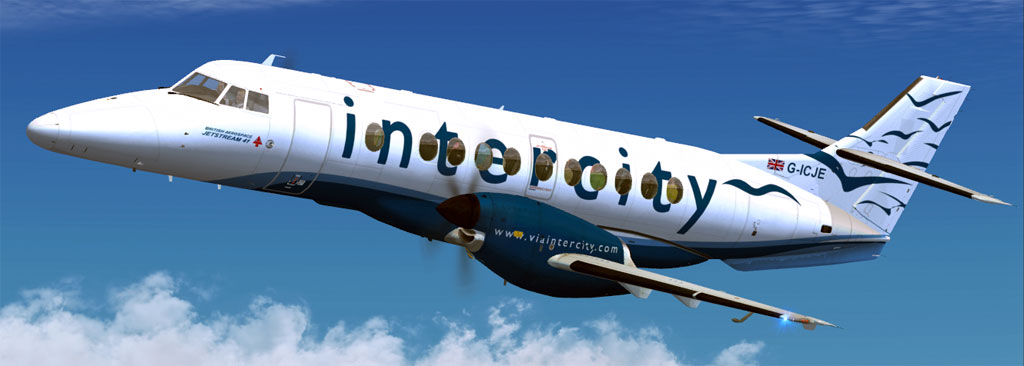BAe-4100 Jetstream 41 with Garrett TPE331-14GR/HR
Twin turboprop low-wing monoplane airliner with cruciform tail and 3 abreast seating

| PMDG | Textures only, FSX |
| Carenado | Saab 340 substitutes (no textures available), P3D |
| Carenado | Saab 340 substitutes (no textures available), XP11 |
| Microsoft | ATR 42-600 replaces, MFS |
| ICAO type | JS41 |
| ICAO class | L2T |
| ICAO category | M |
| ICAO equipment | /G/W/Y |
| Take Off Distance (m, TODR at MTOW in ISA) | 1523 |
| Service ceiling (FL) | 250 |
| Cruise speed (VC, KTAS) | 260 |
| Max speed (VMO, KTAS) | M.52 / 295 |
| MTOW (kg) | 10886 |
| Range (nm at MTOW) | 559 |
| Number in fleet | 27 being replaced by AT42 |
| Seating (Intercity configuration) | 29; Y29 @ 31″ 3 abreast |
Flight Simulator pilots will find the Jetstream 41 has a steep learning curve but is a very rewarding aircraft to fly. The TPE331 engines are geared directly to the propeller and run at 95-100% rpm throughout flight; the thrust levers control propeller pitch and an engine speed governor increases fuel flow as necessary to maintain the RPM commanded by the condition levers. This unconventional configuration provides almost immediate engine response and a high power to weight/size ratio. However, hot ambient temperatures or the use of anti-icing incur a hefty performance penalty.
The Jetstream 41 has its origins in the late ’60s, as a 16 seat feederliner developed by Handley-Page for the US regional airline market, called the HP.137 Jestream. Delayed and four times over budget, the development programme lead to Handley Page’s bankruptcy in 1970.
However, the design showed promise and production was restarted by Scottish Aviation, who merged in to the nationalised British Aerospace (BAe) in 1978. For 1982, BAe upgraded the engines and renamed it the Jetstream 31; with 386 built over 13 years (compared to 66 in the 8 years prior) the design finally proved as successful as initially hoped.
The Jetstream 41 entered service in 1992. Featuring an all new 16 ft/5m longer fuselage, it provided space for 29 passengers, galley, toilet and three crew. The wingspan was lengthened, FADEC engines fitted and the main wing spar now passed under the cabin rather than through the aisle! Up front, a five screen EFIS flightdeck and FMS were supplied by Honeywell. Active Noise Suppression was also an option.
Sales were initially strong as it was cheaper to buy than the competing Saab 340, Dornier 328 and Embraer 120 Brasilia. However, the small and noisy cabin, plus lack of performance at high gross weights led to it falling victim to the regional jet revolution. Production was terminated somewhat prematurely at 100 units in 1997, after BAe joined the AI(R) consortium, as AI(R)’s ATR42 turboprop airliner was felt to better serve the market segment.
In service, the Jetstream 41 has proved to be economical and reliable, hence Intercity choosing them. The J41 is likely to remain in service with airlines for many years as there are currently no 29 seat turboprops in production.

